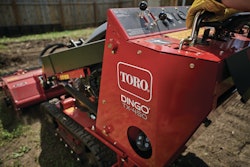Responding to the needs of its customers, JCB has introduced the first four models in a completely new range of high-boom Lift & Place Loadall telescopic handlers.
The new machines were designed by JCB to meet the specific needs of American contractors and rental companies.
The high-boom Loadalls feature larger cabs, side-mounted Tier III-compliant engines, an easy-to-use, plus pattern servo hydraulic control lever and rear-axle stabilization on all but the smallest models.
The Loadall 506-36, which replaces the 506C, provides a lift capacity of 6,000 pounds and a working height of 36 feet. A second machine the 507-42 , replaces the 506CHL and provides a 7,000 pounds maximum lift capacity and a working lift height of 42 feet. A third machine, the 509-42, also has a 42-foot lift height, but can handle loads up to 9,000 pounds. It replaces the 508C model. Topping the range is a new machine with a 10,000-pound lift capacity. With a working height of 56 feet, the 510-56 is a heavyweight telescopic that can handle virtually any lifting task on the construction job site.
The side-mounted engine on new machines, a common feature on JCB™s compact and low-boom telescopic handlers, is mounted at 90 degrees to the frame, offering easy access for servicing and maintenance. Yet another benefit is its high degree of parts commonality with other JCB Loadalls, thus allowing dealers and operators of multiple-machine fleets to maintain fewer parts in inventory.
Engine Choices
The 506-36 is powered by an 85-h.p. JCB motor. The 507-42 and 509-42 models use JCB™s 100-h.p. DieselMax engine. The 510-56 comes with a powerful 114-h.p. version of the EPA and CARB-compliant power plant. All four engines deliver power through JCB™s standard 4×4 Power Shift transmissions and JCB axles. The axles come with torque-proportioning differentials as a standard feature and the outboard planetary hubs help to reduce repair and maintenance costs,
Operators may choose from several tire options: air-filled, eco ballast, puncture sealant and foam filled all of which enable operators to tailor the tires to their individual job site requirements. However all lift capacities are set without tire ballast. Service brakes are self-adjusting oil-immersed discs that require no maintenance. Heavy-duty axle shafts offer long service life and low operating costs.
Growing Market Segment
With its new 510-56 Loadall, JCB is entering an important, growing sector of the market. This 10,000-pound capacity telehandler will be equipped with axle-mounted stabilizers as standard for superior chassis leveling with the stabilizer legs down.
All four machines benefit from a lower cab mounting and a larger, ergonomically designed cab interior. The cab™s easy-to-operate plus pattern servo lever with proportional and flowshare capability provides precise control, coupled with a fast cycle.for ™extra™ productivity. It replaces the multiple mechanical levers found in previous models.
Positioning the boom high on the machine allows for good operator visibility when working or traveling. A hydraulic cylinder mounted underneath the outer extends the intermediate section
with chains for second and third stages, where fitted. The top hat boom design uses a Waxoyl lubricant exclusive to JCB. The lube is dry to the touch and will not attract grit or dirt that can harm the machine. Wear pads are easy to remove and replace when necessary.
The boom on each model machine comes with a quick hitch that enables operators to use a wide variety of JCB and proprietary attachments, which further enhances the versatility of each model.
Three Cab Levels
All models are fitted with a new cab design that incorporates a large glass area improving upward and all round visibility particularly to the rear three quarters, aided by the innovative chassis design.
The cab is available in three levels, from the base canopy to the top-of-the-range Ultra cab. Canopy-to-cab conversion kits also are available for operators who elect to change to a cab at a later date. The split-door design allows the upper glazed section of the cab to be locked open for improved ventilation. Large grab handles provide for easy operator access.
Foot pedals suspended above a flat floor make it easy to keep the cab clean on the job site. The large brake pedal enables operators to brake using the right or left foot.
The easy-to-read instrument layout offers intuitive controls, with load charts available for standard carriage, tilt and truss boom operation. A wide range of attachments will be available for the various models, from utility buckets and pallet forks to truss booms and block tines.
The new machines were designed for use by framers, roofers, steel erectors, masons and general contractors. They will be manufactured at JCB™s modern production facility in Savannah.
JCB has 17 plants on four continents: 10 in the UK, three in India and others in the U.S., China, Germany and Brazil. The company employs more than 8,000 people worldwide.
JCB celebrated its 60th anniversary in 2005. The company is privately owned by the Bamford family. Its Chairman, Sir Anthony Bamford, is the son of the company™s late founder, Joseph Cyril Bamford, for whom the company is named. JCB manufactures more than 279 distinct machines including: backhoe loaders, Loadall telescopic handlers, tracked and wheeled excavators, wheeled loading shovels, articulated dump trucks, rough terrain fork lifts, mini excavators, skid steers loaders, JCB Vibromax compaction equipment and ground-care equipment. For agricultural markets, the company produces a range of telescopic handlers and the unique Fastrac tractor. JCB also manufactures the Teletruk forklift for the industrial sector.
JCB has won more than 50 major awards for engineering excellence, exports, design, marketing, management and for environmental care.










